NRAO eNews
Volume Vol#, Issue Iss#
Day# Month# Year#
NRAO eNews
Volume Vol#, Issue Iss# • Day# Month# Year#

Upcoming Events

ngVLA Summer Short Talks
Thursdays, 3:00pm EDT, Jun 25, 2020 - Sep 10, 2020 | Virtual
NRAO Semester 2021A Call for Proposals

The National Radio Astronomy Observatory (NRAO) invites scientists to participate in the Semester 2021A Call for Proposals for the Karl G. Jansky Very Large Array (VLA) and the Very Long Baseline Array (VLBA), High Sensitivity Array (HSA), and Global 3mm VLBI Array (GMVA).
The submission deadline for Semester 2021A proposals is Monday, 3 August 2020, at 17:00 EDT (21:00 UTC).
We would like to highlight that NRAO is offering staff assistance with VLBA observation setup and data reduction for new and novice VLBA users. For more information see the VLBA, HSA and GMVA Proposal Guide.
Proposal preparation and submission are handled via the NRAO Proposal Submission Tool (PST) available at NRAO Interactive Services. Proposers who need assistance with proposal preparation or have questions regarding the Call for Proposals or NRAO telescope capabilities should contact Observatory staff via the NRAO Helpdesk. Note that using these tools (both the PST and the Helpdesk) requires registration.
GBT Semester 2021A Call for Proposals
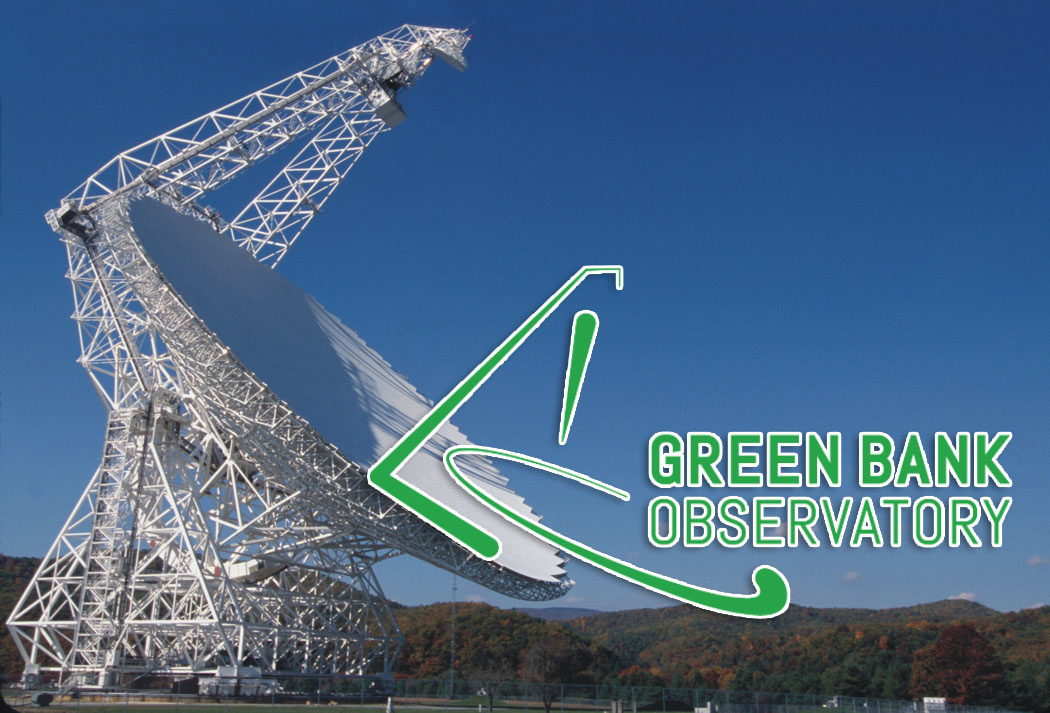
The Green Bank Observatory (GBO) invites scientists to participate in the 2021A Semester Call for Proposals for the Green Bank Telescope (GBT).
The submission deadline for Semester 2021A proposals is Monday, 3 August 2020, at 17:00 EDT (21:00 UTC).
Receiver availability for the 2021A semester will be determined by those highly-ranked proposals accepted in Group A.
The GBT is happy to announce a new opportunity for joint observations with SOFIA. Up to three percent of the U.S. Guest Observer time on SOFIA will be made available for requests in GBT proposals.
The GBT only accepts large proposals once per year, at the February proposal deadlines. We will no longer accept GBT large proposals at the August proposal deadlines. The next large proposal deadline for the GBT, after this call, will be for the 2021B semester. This new policy ensures equality for the reviews of all large proposals that can be scheduled across a full year.
Recall that all large proposals are restricted to using no more than 50% of the open skies time available under any weather category (poor, good, excellent) at any LST during any semester.
Additional information, including the complete GBO Semester 2021A Call for Proposals is available online.
NRAO/GBO Status
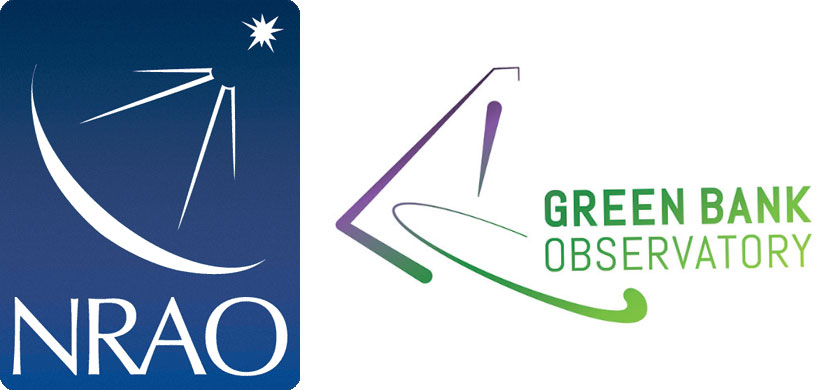
The National Radio Astronomy Observatory (NRAO) and the Green Bank Observatory (GBO) are six weeks into their return to full operations, Phase 1. The North American NRAO/GBO instruments remain operational, IT systems are working well. In Chile, the Office of Chilean Affairs and our NRAO International Staff Members in the Joint ALMA Observatory remain in Infectious Disease Operating Status, with some easing of the situation in Chile seen recently.
Across the NRAO/GBO sites, there have been troubling changes to our risk exposure. The states of New Mexico and West Virginia are both seeing a resurgence of new infections; Virginia has been more or less constant. Around the United States, some regions/cities are seeing huge increases, probably driven by changes in lockdown restrictions, social events, etc., a few weeks ago. A basic assumption in the NRAO/GBO return to full operations planning is the number of infections decreasing in our states/regions. We are, unfortunately, not seeing that.
In most respects, the NRAO/GBO return to full operations has been successful. The Very Large Array was reconfigured, we are still delivering great data and support to the community, much telework progress is being made, i.e., the wheels of the Observatories are turning fine. But difficult challenges lie ahead: students returning to school/university in the next 4-8 weeks will be complex and stressful. Whatever models the school districts/colleges adopt, we should be prepared for them to change rapidly, including events driving education virtual for the rest of the school year, and parts of the Observatory shifting back towards lockdown.
We hope for the best, but plan for a full range of outcomes.
ngVLA Project News
ngVLA Summer Short Talk Series
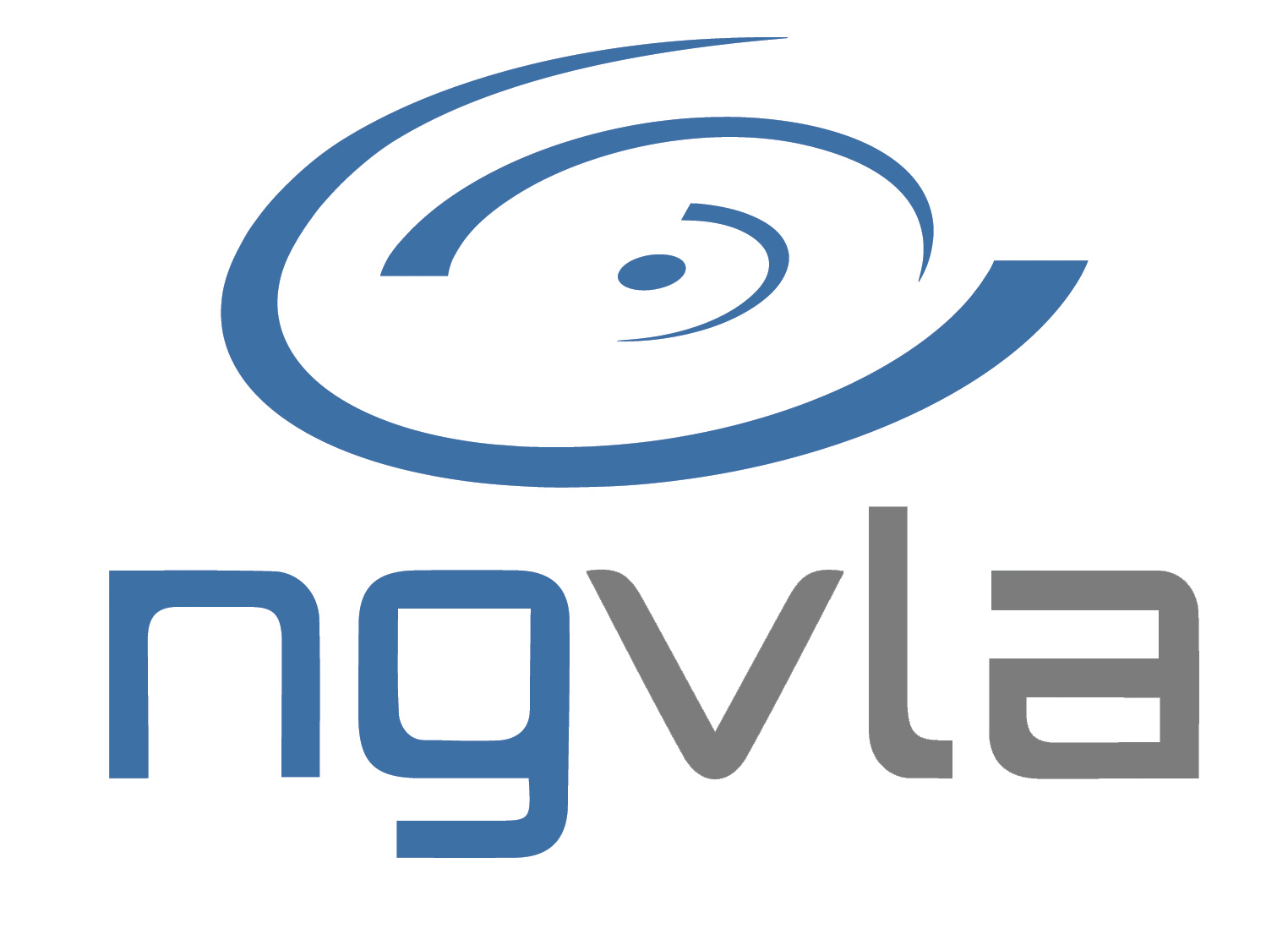
The NRAO and the Next Generation Very Large Array (ngVLA) Science Advisory Council are pleased to announce an online ngVLA Summer Short Talk Series, each Thursday at 3 p.m. Eastern Daylight Time through 10 September. Each 20 to 25-minute talk will highlight open science questions and their connection to present and future observing facilities at all wavelengths. A moderated, 20-minute, audience Q&A session will accompany each talk. The talk schedule and information regarding registration and attendance is online.
New Views of Galaxy Formation and Evolution
The NRAO will convene a Special Session at the January 2021 American Astronomical Society (AAS) meeting titled New Views of Galaxy Formation and Evolution (exact date/time TBD).
Sensitive ground- and space-based astronomical facilities are pushing the detection of galaxies well into the Epoch of Reionization (EoR), less than 1 Gyr after the Big Bang. Such observations are allowing us to begin piecing together how and when the first galaxies formed, along with the physical processes driving their evolution to mature systems in the local Universe. While existing facilities are making transformative discoveries by pushing their capabilities to the limit of what can be detected at the earliest times, sample sizes remain small as detections of individual systems are limited to the most luminous sources or those whose detections are afforded by strong lensing. Informed by these pioneering efforts, suites of next-generation ground- and space-based facilities will marshal a new combination of large area, deep multi-wavelength surveys that will characterize the accretion, star formation, molecular gas, and stellar mass histories for large populations of galaxies back into the EoR and beyond. When combined with a detailed accounting of the kinematics, chemical abundances, and energetic processes associated with these systems, such studies will yield a self-consistent framework that will revolutionize galaxy evolution, leading to a much-improved theoretical understanding of the fundamental physics driving the formation and evolution of galaxies.
This Special Session will highlight recent scientific breakthroughs in galaxy evolution enabled by investigations using large optical/IR, (sub-)millimeter, and radio facilities; describe planned near- and long-term improvements for ground- and space-based facilities; discuss major scientific leaps likely to result from next-generation facilities across the electromagnetic spectrum; and review the highest-priority themes in galaxy evolution that will be accomplished by the state-of-the-art observatories that will be commissioned in the next decade. This Special Session will feature a session of invited oral presentations and an associated poster session with contributed presentations.
The confirmed speakers include Mark Dickinson (NOIRLab), Linda Tacconi (Max Planck Institute for Extraterrestrial Physics), Justin Spilker (University of Texas), Xiaohui Fan (University of Arizona), Chris Willott (Herzberg Astrophysics), and Rachel Sommerville (Flatiron Institute).
We encourage you to consider contributing to the associated poster session. When submitting a contributed poster abstract to the January 2021 AAS meeting, you will have the option of requesting that your presentation be included in this Special Session.
Cold Gas in Galaxies with the ngVLA
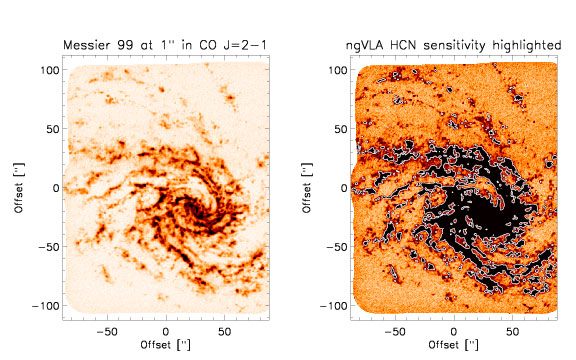
Highlighting ngVLA's power to detect faint molecular lines at high angular resolution (Leroy et al. 2018). [Left] CO emission in M99 from the PHANGS-ALMA survey at 1 arcsec ~ 100 pc. [Right] White contours are regions where brightness of the density-sensitive lines would be expected to match the sensitivity of the ngVLA in one hour.
[click to enlarge]
Across the Universe, stars form deep inside dense, cold clouds of mostly molecular gas. The density, temperature, and motions of this gas play key roles in the birth of stars, star clusters, and planets. While we have begun to measure the amount of cold gas in galaxies across the universe (Carilli & Walter 2013, Tacconi et al. 2020), we still know relatively little about these physical conditions in the cold gas. A major frontier in understanding galaxy evolution is to link the properties of galaxies to the internal state of the gas, by mapping out how density, temperature, and other physical conditions in the cold gas change from galaxy to galaxy and how these properties link to star formation.
Long-wavelength molecular spectroscopy offers a powerful tool to measure these conditions. In the centimeter-, millimeter-, and submillimeter-wave parts of the spectrum, the molecules in cold gas clouds emit via a host of (mostly rotational) transitions. These transitions have different sensitivities to the density, excitation, chemical, isotopic, and elemental makeup of the gas (Shirley 2015). Combining observations of multiple lines offers a window into the physical state of the gas in galaxies.
The major challenge to mapping out physical conditions in the gas of other galaxies is that, except for the CO lines, most of the key transitions remain very faint compared to the sensitivity of current telescopes. The contrast between rotational lines of CO and those of HCN, HCO+, CS is often taken as a density diagnostics and used to link density and star formation (Gao & Solomon 2004, Jimenez Donaire et al. 2019). But these lines are typically 30 times fainter than CO. Even with ALMA, observing these lines in even the nearest galaxies require a massive time investment and detections are not guaranteed (Gallagher et al. 2018, French et al. 2018).
The key transitions lie at frequencies below 100 GHz and this field needs a massive increase in sensitivity to enable the next major goals. Astronomers in this field are extremely excited about the prospect of the Next Generation Very Large Array (ngVLA). At the relevant frequencies (~20-120 GHz), the ngVLA offers an order of magnitude improvement in effective collecting area compared to ALMA (Bolatto et al. 2017). This allows the prospect for detailed, rich spectroscopic surveys that diagnose the physical conditions in each individual cloud in an external galaxy. It will also allow population studies that link physical conditions in the cold gas to the properties and structure of galaxies across the whole galaxy population and cosmic time.
This article continues a regular feature intended to highlight contributions to the ngVLA Science Book. We are especially interested in showcasing work done by early-career researchers. Anyone wishing to volunteer to author a feature should contact Joan Wrobel.
VLA Sky Survey Epoch 2
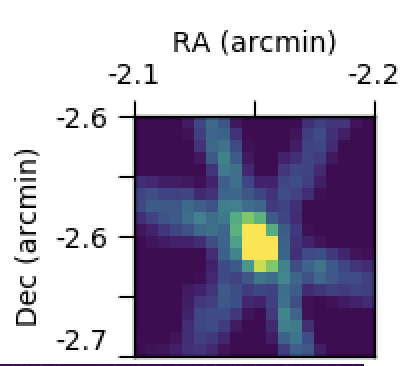
Localization image of the pulsar B0031-07 made from the realfast data stream.
[click to enlarge]
The VLA Sky Survey (VLASS) began its second epoch of observing the entire sky visible to the Very Large Array on 26 June with the start of the VLASS2.1 observing campaign. Observations will continue in B and BnA configurations until 2 November 2020, and will cover half the sky, with the remaining half of the second epoch scheduled for Fall 2021 in the VLASS2.2 campaign. VLASS2.1 will cover the same sky locations as the VLASS1.1 campaign (observed from September 2017 to February 2018), allowing a direct comparison between two VLASS epochs for transient searches. Quick Look images will be produced within 2-4 weeks of observation. All Quick Look images for the first epoch are now available; see the Quick Look Users' Guide for details.
As during many other VLA observations, the realfast transient detection system runs continuously during VLASS observations. During early VLASS 2.1 observations the realfast team were able to localize a previously-known pulsar, B0031-07. The realfast system was able to detect and classify the pulsar within 3 minutes of the observations, locate the pulsar to a positional accuracy of better than 0.5 arcseconds, and demonstrate sensitivity to pulses of a few mJy with 18ms time resolution.
ALMA Program News

Antenna Site Erection Facilities (SEFs) at the Operations Support Facility (OSF), July 2010. [Left] ESO SEF, [Center] NAOJ SEF, [Right] NSF SEF. Antennas were assembled and underwent preliminary tests at the SEFs before being moved to the main OSF staging area for final testing.
[click to enlarge]
ALMA Science Sustainability
The ALMA Board issued The ALMA Development Roadmap (ALMA Memo 612) to guide prioritization of activity to sustain ALMA scientific productivity. Additionally, this year a number of White Papers were submitted to the Astro2020, one focal point of which is to harness the tremendous power of (sub)millimeter observations to pinpoint and characterize the chemistry of planets in formation. A major upgrade of ALMA spectral sensitivity will be needed in the coming years. Several initiatives to accomplish this are under way, addressing increasing ALMA sensitivity and spectral grasp among other goals. Outfitting of ALMA for 35-52 GHz operation is in progress, led by the East Asian (EA) partner; a prototype wideband receiver for 67-90 GHz is in late Development stages (ESO/EA), as is a next generation wideband 211-280 GHz receiver (North America/EA). To address the wider IF ranges accommodated by these receivers, a TALON-based Correlator Study (Lead Institution: NRC-Herzberg) will soon be completed. Studies of how to incorporate an array with extended baselines on the ALMA site are also under way.
New ideas for improvements to ALMA are welcomed through Calls for ALMA Development Projects and Studies. The schedule for the Cycle 8 Call for North American Development Project Proposals is delayed by six months due to COVID-19. The schedule for the Cycle 8 call for North American Development Study Proposals proceeds as planned: submissions are under review by an external panel.
The ALMA Development Projects Implementation Plan is available for review and describes the fundamental processes for project proposal and review. The North American (NA) call for proposals will be open to the NA ALMA Operations Partnership, which is defined as the community of astronomers and scientists in related fields from NA ALMA partner countries. Projects will be funded for Cycle 8 in an integrated, multi-year award. Priority will be given to those Projects which align with the ALMA Development Roadmap (ALMA Memo 612). Topics of particular interest to the NA ALMA Partnership include larger bandwidths and improved receiver sensitivity, such as would be provided by an upgraded correlator and receivers.
The date of issue for the Cycle 8 Call for North American Development Project Proposals will be 15 January 2021. Project execution can only begin after adjudication at the April 2022 ALMA Board Meeting. If you are planning, or even considering, proposing in response to this Call, you must file a Notice of Intent before 28 February 2021. In contrast to previous Calls, submission of a Notice of Intent is mandatory. Additional details will be released with the Call in January 2021. The deadline for receiving the proposals will be 15 April 2021.
Second Generation Correlator proposals must meet the specifications of the Correlator Working Group report, the first draft of which is expected by the proposal call date. All proposals and resulting instrumentation must comply fully with ALMA standards for system interfaces, interoperability, and documentation. NRAO staff can help applicants develop plans or steer them toward relevant documentation, upon request and with sufficient notice.
ALMA Operations
The COVID-19 pandemic continues to impact the global community, including ALMA users and staff. The situation in Chile remains critical, with many cities under quarantine and with restrictions on movement. Accordingly, ALMA is not anticipating starting its return to operations yet and staff remain working from home until further notice. While ALMA operations remain suspended, staff have been working actively on plans to restart operations at a time that they become feasible. In these unprecedented circumstances, ALMA’s first priority is the health and safety of all its staff, many of whom travel long distances by bus and plane to reach the remote ALMA telescope site in the Atacama Desert of northern Chile. At this time, and given the current evolution of the COVID-19 outbreak in Chile, it is unclear when a ramp up to start operations could begin, or when a restart of science operations will be possible. ALMA is working on guidelines and considerations for the restart of operations and will provide a next update to the community in the coming weeks.
In the meantime, Caretaker teams continue to maintain the safety of the ALMA equipment and infrastructure in both Santiago and in San Pedro, while all other staff continue to work remotely from their homes. The Regional ARCs continue to provide support to their communities. If you have any questions, comments or concerns related to the situation at ALMA, please contact the HelpDesk.
Historical Milestones
Twenty Years Ago: Astronomy and Astrophysics in the New Millennium (2001) report of the NRC Board on Physics and Astronomy reaffirmed the recommendations of the 1991 committee by endorsing "… the completion of the Millimeter Array (MMA; now part of the Atacama Large Millimeter Array).”
Fifty Years Ago: Beginning in the mid to late 1960s, improvements in telescope technology enabled molecular observations which gradually revealed the cold Universe to astronomers, beginning with OH (Weinreb et al. 1963), ammonia (Cheung et al. 1968), water (Cheung et al. 1969) and formaldehyde (Snyder et al. 1969) and culminating in the discovery of CO in 1970 (Wilson et al.). While the earlier molecules suggested a significant cold component to the interstellar medium, the discovery of the ubiquity of strong CO emission surprised astronomers. Its widespread emission suggested that the cold dense phase of the interstellar medium was pervasive and significant – at last the cold dense dust which had foiled optical observations could be measured through its coexisting gas via molecular lines. This promise has been realized throughout the Universe over the last fifty years of observations.
Martha Haynes Awarded the 2020 Jansky Lectureship
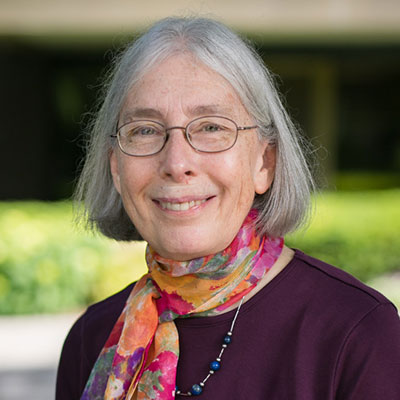
Prof. Martha Haynes
[click to enlarge]
Associated Universities, Inc. (AUI) and the NRAO have awarded the 2020 Karl G. Jansky Lectureship to Dr. Martha P. Haynes, Goldwin Smith Professor of Astronomy at Cornell University. The Jansky Lectureship is an honor established by the trustees of AUI to recognize outstanding contributions to the advancement of radio astronomy.
Professor Haynes is being honored for her influential impact to our understanding of galaxies. She has made important contributions to our knowledge of the atomic hydrogen (HI) content of galaxies, environmental effects on gas, and large-scale structure in the local Universe. She was responsible for the first three-dimensional view of remarkable large-scale filamentary structures, based on HI observations of the galaxies in the Pisces-Perseus supercluster.
Her work showed that galaxies are clustered on scales of tens to almost 100 Megaparsecs, considerably more extensive than previously demonstrated. This completely altered our view of the scale of inhomogeneities in the universe, now recognized as a fundamental tenet of cosmology.
Haynes has also been a leader and advocate for the development of instruments to expand our ability to probe the radio universe. She provided oversight and vision to the improvements made to the Arecibo Radio Telescope in Puerto Rico, culminating with the ALFALFA HI Survey, which covered one-sixth of the sky and detected an astonishing 31,000 galaxies. She currently is a leader of the collaboration building the CCAT-prime submillimeter telescope in Chile.
She has served as an advocate for radio astronomy at the highest national and international levels including vice chair of the 2010 Decadal Survey and vice president of the IAU (2006-2012). From 1981-1983 she was NRAO’s Assistant Director for Green Bank and from 1998-1999 she served as Interim President of AUI where she gave broad oversight to the operation of NRAO and led the early negotiations leading to the establishment of the Atacama Large Millimeter/submillimeter Array (ALMA).
Haynes’ achievements have been recognized through her election to the American Academy of Arts & Sciences in 1999, her election to the National Academy of Sciences in 2000, and through numerous highly-prestigious awards. Her professional activities have had a significant impact on astronomy policy and planning. In addition, she has been an inspiring teacher and mentor for her many students and a leader in bringing women into the field.
As Jansky Lecturer, Haynes will give (virtual) lectures at NRAO facilities in Charlottesville, Virginia, and Socorro, New Mexico. These lectures are open to the public.
First awarded in 1966, the Jansky Lectureship is named in honor of the man who, in 1932, first detected radio waves from a cosmic source. Karl Jansky’s discovery of radio waves from the central region of the Milky Way started the science of radio astronomy.
Dark Ages Polarimeter Pathfinder
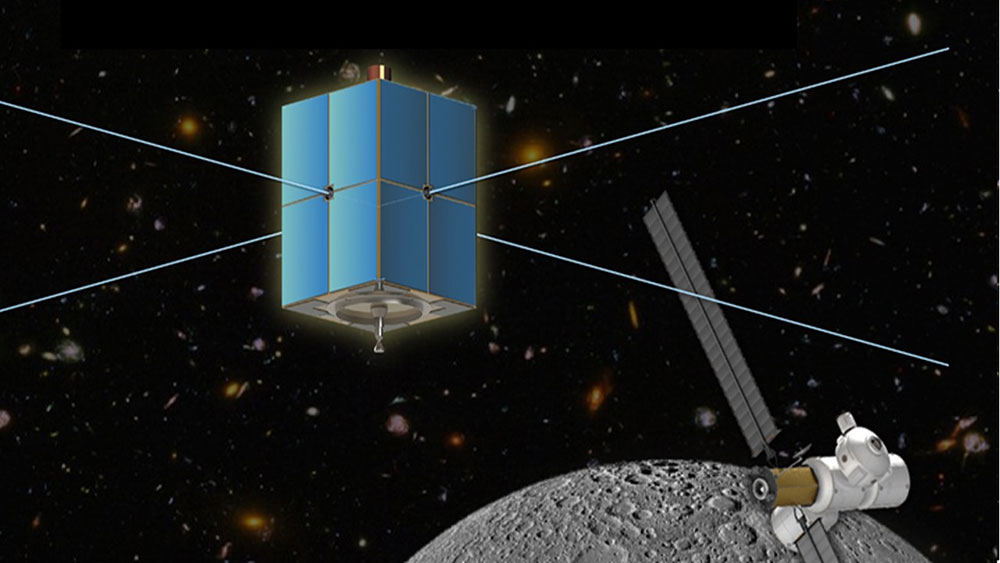
The DAPPER spacecraft (foreground). The NASA Lunar Gateway (background) will relay DAPPER data to Earth.
[click to enlarge]
The NRAO Central Development Laboratory (CDL) is assisting with the development of the Dark Ages Polarimeter Pathfinder (DAPPER), a lunar-orbiting spacecraft concept designed to measure the spectrum of highly-redshifted hydrogen emitted during Cosmic Dawn, the epoch of initial star formation in the evolution of the Universe. The challenge of this measurement in the 20-100 MHz frequency range is the rather weak, isotropic nature of the hydrogen radiation in the presence of strong foreground emission that is many orders of magnitude brighter. DAPPER has several advantages over ground-based instruments in that it is above the signal distorting effects of the ionosphere, clear of local environmental effects that are difficult to model, and will acquire sky data during the time in its orbit when the Moon shields the spacecraft from Earth-based radio interference. It also incorporates a novel dynamic polarimetry technique, developed by Richard Bradley’s group at the CDL, to help separate the foreground spectrum from that of Cosmic Dawn hydrogen.
NASA Ames Research Center is hosting the DAPPER project, led by PI Jack Burns (University of Colorado, Boulder) and Co-Is Richard Bradley (NRAO CDL) and Stuart Bale (Berkeley Space Sciences Laboratory). The purpose of our current two-year program is to advance the Technology Readiness Level (TRL) of the instrumentation to TRL 6 – eliminating the technological risks of the mission. The NRAO CDL will lead the development of the 60-100 MHz antenna, receiver / calibration modules, signal processing algorithms, and the ground-based engineering prototype that will be deployed at the Green Bank Observatory (GBO). The Space Sciences Laboratory will perform the space environmental tests on our prototype hardware and migrate the software to an FPGA-based platform. Data from the GBO deployment will be used by the University of Colorado group to evaluate and advance the capabilities of their machine-learning-based data analysis pipeline for DAPPER.
CDL has formed a new Space Electronics Division (SED) that will serve as the center for space-borne instrument development at the CDL. The SED is directed by Richard Bradley and includes Jansky Fellow Bang Nhan, and Reber Fellows David Bordenave and Krishna Makhija. The program will be managed by Nicholas Gelles, and Patrica Klima will serve as the lead Technical Specialist. We also welcome newly-hired electrical engineer Alec Handy, who will assist with receiver development. In addition, CDL’s Bill Shillue has agreed to serve on the DAPPER Advisory Team. Other CDL staff will be involved with various aspects of the project.
The SED builds upon the work of Marian Pospieszalski who developed flight-ready, low noise amplifiers at the CDL in the 1990s for the highly-successful Wilkinson Microwave Anisotropy Probe (WMAP). In addition to DAPPER, the SED has teamed up with PI David Hollibaugh-Baker at NASA Goddard on a proposal for the Agile Radio for Regolith Observations using Microwaves (ARROW), a portable radiometer that would assist astronauts in findong water ice buried beneath the lunar surface. The CDL SED would lead the development of the broadband antenna operating over the 1-10 GHz band.
New Radio Astronomy History Published
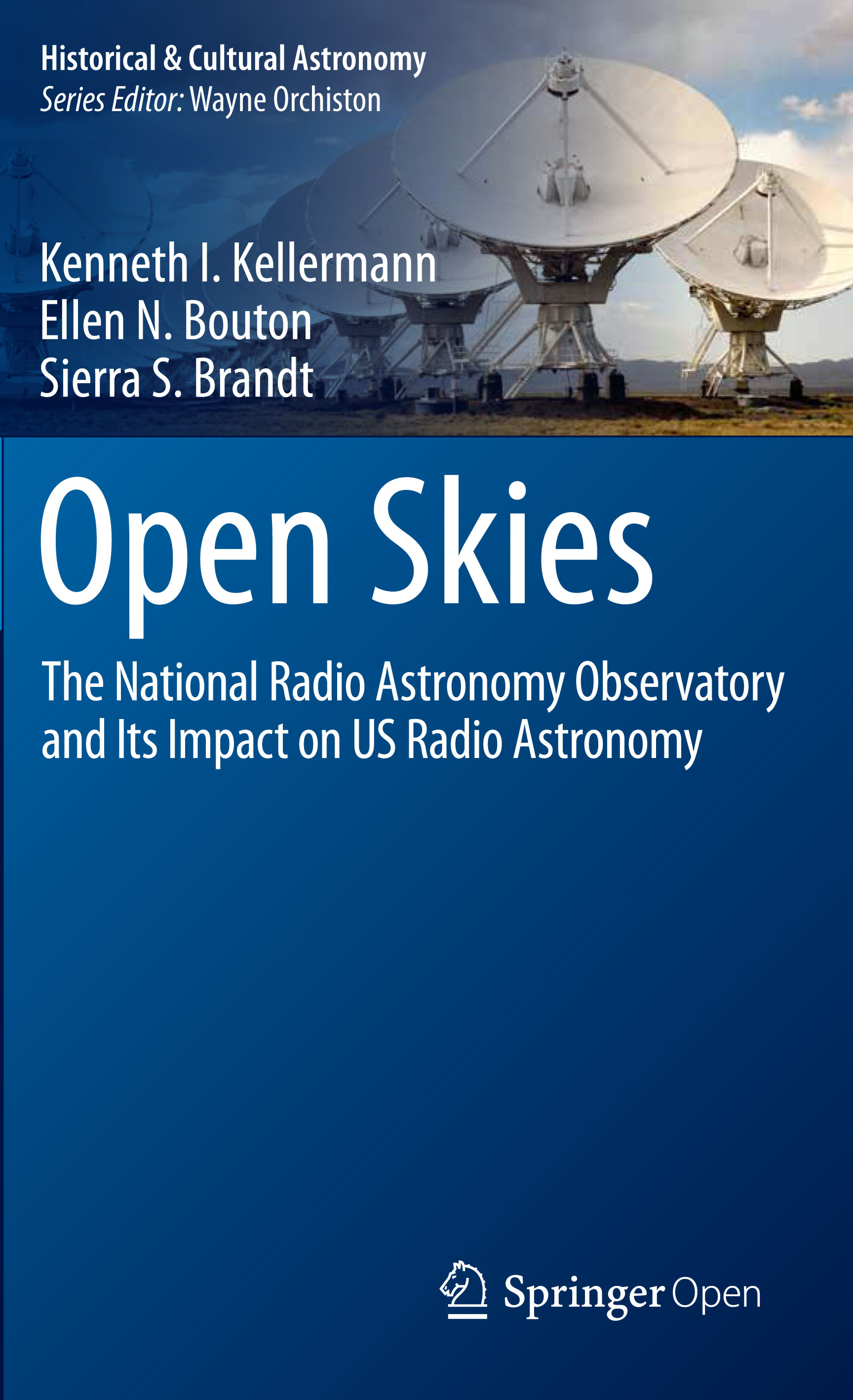
The book Open Skies: The National Radio Astronomy Observatory and its Impact on US Radio Astronomy, by Ken Kellermann, Ellen Bouton, and Sierra Brandt has recently been published by Springer. Open Skies documents the history of NRAO from the time of the first discussions in the early 1950s about building a national radio astronomy facility through the construction of ALMA. The emphasis is on the people and politics involved in creation of NRAO and its unique facilities.
For readers located in the U.S., hard cover printed copies can be pre-purchased for $59.99 USD plus tax from the Springer Open Skies web site. Readers in other countries should use the international web site where the price is 51.99€. Shipping is included in both cases. Springer normally has regular promotions with 20% discounts.
For those affiliated with institutions that have a contract with Springer, a single mycopy soft covered edition for personal use will be available by the end of July for $24.99 including shipping. Mycopy orders must be made using your institution’s IP address (check with your librarian if you are uncertain about your eligibility to purchase a mycopy edition). Using a VPN from another site will not work.
The e-book edition can be downloaded using any ebook reader. There is no charge for the e-book edition.
An Open Skies pdf can be downloaded for free from the Open Skies web site for use on any computer or ebook reader.
40 Years of the AIPSLetter
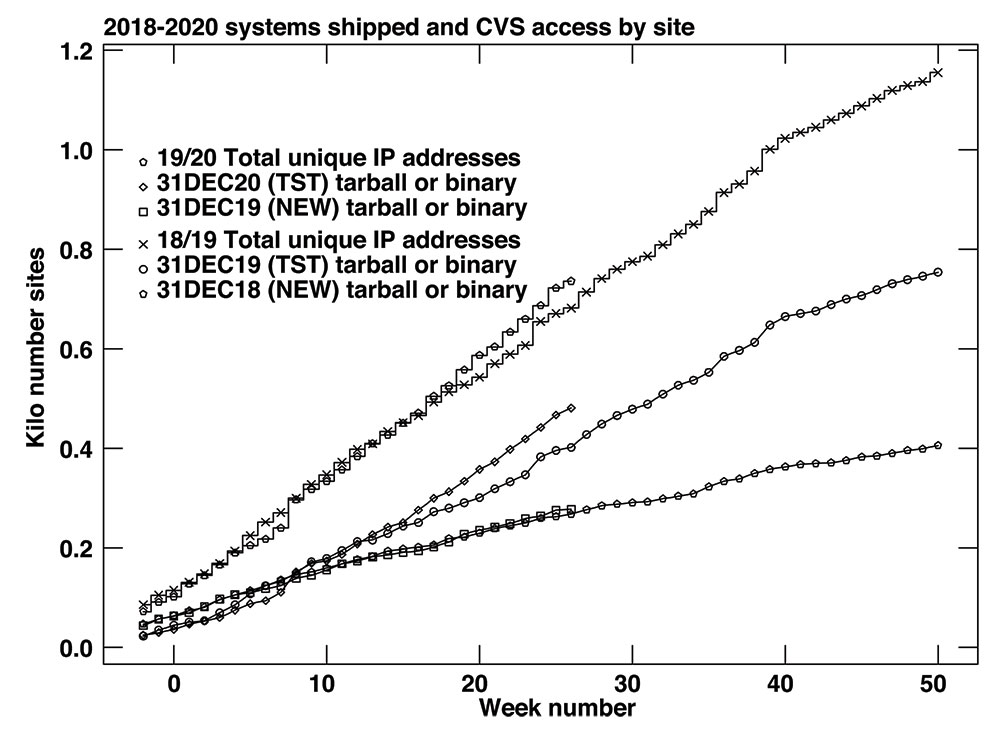
AIPS shipping numbers are currently ahead of last year.
[click to enlarge]
We have completed Volume XL, number 1, of the AIPSLetter for 30 June 2020. Because of COVID-19, there will be no paper copies. NRAO scientific staff and all other interested parties can obtain a copy via our web site, from which you may obtain any and all information about AIPS. A pdf format version is also available.
So far in 2020, a serious bug in RLDLY caused the right minus left delay solution to use less data than expected. A bug in UVFIX caused the differential aberration correction to be a (false) function of time and caused gross errors when converting B1950 to J2000 data. A large number of models for standard calibration sources are now available through AIPS from Rick Perley's web sites. Clean component files may now have a "third dimension" in anticipation of wide-field models of these sources at P band. New task UVRMS gives statistical information about uv data sets and several changes to enhance the testing of Faraday rotation measure synthesis have been made.
In 2019, AIPS was changed to support moving sources (planets) properly and the pseudo array processor code was substantially revised to allow correct compilation with modern versions of gfortran. IMAGR and other imaging tasks were revised to re-scale and convolve the residual image whenever the user specifies the Clean beam size. The VLBA pipeline reduction script VLBARUN was enhanced with multiple flagging options, editing of the TY table, improved imaging of spectral-line data, and better display of the results in the output html file. To go with this pipeline, a new pipeline VLBAMPHC was written to calibrate and image observations correlated with multiple phase-stopping centers.
Recent Media Releases
From the Archives
Ellen Bouton

[click to enlarge]
About this month's photo: After years of construction, months of planning for the event, and with 2,000 guests in attendance, the Robert C. Byrd Green Bank Telescope was dedicated on 25 August 2000. Senator Byrd delivered the keynote address at the ceremony; NSF Director Rita Colwell, NASA Administrator Dan Goldin, and AUI President Riccardo Giacconi also offered remarks. The weather was lovely, a band played, lunch was served to all the guests, and the "thump, thump, thump" of PSR B1133+16 played over loud speakers to open the ceremony.
Planning an event of such scope required months of work by a dedicated Organizing Committee from across the Observatory. In this photo, some members of the Committee discuss plans and strategies for the successful event. Clockwise from left: Phil Jewell, Mike Holstine, Shirley Curry, Rusty Taylor, Chuck Beverage, Carol Ziegler, Rebecca Johnson, and Tony Beasley (before leaving NRAO, then returning in 2012 as Director).
From the Archives is an ongoing series illustrating NRAO and U.S. radio astronomy history via images selected from our collections of individuals' and institutional papers. If readers have images they believe would be of interest to the Archives, please contact Ellen Bouton.

